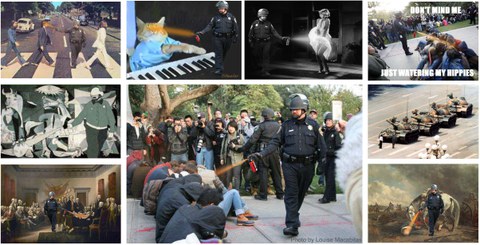Jan 17, 2022
Internet memes, videos of police violence and protests on social media

Image caption: “Pepper spray cop” photoshopped meme; photograph taken during the Occupy protests at UC Davis in 2011 and resulting internet memes
We’ve all seen them: photos of demonstrations, videos of violence, or memes of politicians being shared and going viral on social media. What effect do these images of protest have? Do they spur to action? Do they just serve to document the events that unfold? Or should we view them as key players in a movement?
Prof. Kerstin Schankweiler, Professor for Visual Culture Studies in a Global Context, Dr. Verena Straub and Tanja-Bianca Schmidt explore these and other questions in their research project Visual Protests on Social Media: Internet Memes, Videos of Police Violence and References to Art.
“The goal of the project is to explore the significance of images of protests on social media,” Prof. Kerstin Schankweiler explains. “We would like to demonstrate that political protest cultures are interwoven on a global scale and that they cultivate photographic practices, aesthetics and genres. However, we have to consider that visual protests are also characterized by their local contexts and influenced by geopolitical and economic power structures.”
Three subprojects are dedicated to this topic. Subprojects 1 and 2 address internet memes in political contexts and videos of police violence. Both are particularly viral forms of visual protest on social media. On another level, subproject 3 focuses on how these visual protests are appropriated and reflected in contemporary art. This prioritizing of objectives enables the analysis of three very different yet equally central aspects of digital visual protest and their reciprocal relationships.
One prominent example is the “pepper spray cop” meme which was widely shared online starting in 2011. The meme was created in response to a case of documented police violence, where the police officer pictured casually walks along a row of Occupy protesters at the University of California, Davis, and pepper-sprays them. The caustically captioned images that subsequently coursed through social media condemned the police officer’s actions, sometimes with an ironic twist in combination with well-known images from pop culture and art history. The goal of the project is to characterize the momentum and ambivalence of visual protests whose political intentions can be difficult to comprehend.
In addition to the contemporary view of visual protest, the project also assumes a historical perspective. “This vantage point will hopefully help us to examine the extent to which digital visual protest practices tie in with comparable practices in the history of art and visual culture in the 20th century,” says Dr. Verena Straub. And, she adds, “the extent to which the specificity of new image economies on social networks has led to a radical reconfiguration of political visual protest.”
The researchers seek to supplement their work by testing new digital methods of research, thus developing an innovative mix of methods of researching social media content in the context of visual culture studies.
The project will be launched at the start of this year and will receive funding from the German Research Foundation (DFG) for 3 years.
Media inquiries:
Prof. Kerstin Schankweiler
Chair of Visual Culture Studies in a Global Context
Tel: +49 351 463-35710
Email:
Dr. Verena Straub
Co-head of the DFG project
Email: verena.straub@tu-dresden.de
